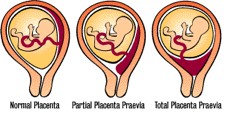FOCUS: Male Infertitlity
Did you know that 7.5% of all sexually experienced men younger than age 45 reported seeing a fertility doctor during their lifetime?
FOCUS: Female Infertitlity
Did you know that 6-10% of married women 15–44 years of age are unable to get pregnant after one year of unprotected sex ?
PLACENTA PRAEVIA
-
What is placenta praevia, and how common is it?
Placenta praevia (also known as low lying placenta) is a complication of pregnancy, when the placenta is in the lower segment of the uterus and covers part or all of the cervix. Between three and six of every 1000 pregnant women have this problem. Bleeding may be a symptom of the condition. As the lower part of the uterus stretches in the second half of pregnancy, the placenta may become detached, causing severe bleeding. The baby cannot be born vaginally if the placenta is totally obstructing the opening from the womb.
Uncontrolled bleeding (haemorrhage) is life-threatening for both mother and baby, although this is rare. If the bleeding doesn't stop, or if the mother goes into premature labour, the baby will need to be delivered by caesarean section even if the date on which he was due isn't for quite a few weeks.
Placenta praevia can be divided into four types, of which the first two are the most common:
- I the placenta is positioned low in the womb, but the baby can still be born vaginally.
- II the lower edge of the placenta touches the opening of your cervix, but does not cover it, so the baby can be born vaginally.
- III the placenta partially covers the opening of your cervix. The baby will need to be born by caesarean section.
- IV the placenta completely covers the opening of your cervix. The baby will need to be born by caesarean section.
If you have an ultrasound scan in early pregnancy and the placenta seems to be near, or even covering the cervix, don't be too alarmed. It almost certainly is not placenta praevia. As your baby grows, your expanding uterus naturally pulls the placenta away from your cervix. Even if the placenta is still low-lying at your 20-week scan, it may well not present a problem once you are full-term.
Guidelines published by the National Institute for Clinical Excellence (NICE) in 2003 recommend that all women whose placenta covers the opening of the cervix at any point in pregnancy should be offered an extra ultrasound scan at 36 weeks. In the majority of cases this scan will show that the placenta has moved.
What does placenta praevia look like?
-
What are the warning signs of placenta praevia?
Painless vaginal bleeding during the last three months of pregnancy is often a warning sign and you should call your GP or midwife immediately if this happens. However, there may be no warning signs at all and the fact that you have placenta praevia may only be discovered during a routine ultrasound scan.
-
Are some women more at risk than others?
Women who are having their second or subsequent baby are more at risk than women having their first. Also slightly more at risk are women who have given birth to a baby by caesarean section, or who have previously had a pregnancy with placenta praevia, or who smoke. However, most women with placenta praevia have no obvious risk factors.
-
How is placenta praevia managed?
This depends on whether you're bleeding and how far on in your pregnancy you are. If the condition is diagnosed after the 20th week, but you're not bleeding, you'll probably be advised to refrain from any vigorous exercise and to take life easy. If you're bleeding heavily, you will be admitted to hospital so that the bleeding can be monitored, but even when it stops, you might well be asked to stay in hospital until your baby is ready to be born.
LOVE QUOTE OF THE DAY
"Love you will find only where you may show yourself weak without provoking strength."
